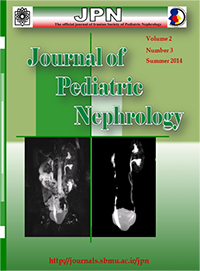Introduction: Chronic Kidney Disease (CKD) is defined as renal injury and/or a glomerular filtration rate below 60mL/min/1.73m2 for more than 3 months. Neurologic symptoms in CKD include fatigue, poor concentration, headache, drowsiness, memory loss, seizures, and peripheral neuropathy. Obsessive-Compulsive Disorder (OCD) is a chronic disabling illness characterized by repetitive, ritualistic behaviors over which the patients have little or no control. Common obsessions include contamination and thoughts of harming loved ones or oneself. Washing and cleaning compulsions are common in children, as is checking. The purpose of this study was to investigate the relationship between OCD and CKD.
Materials and Methods: In this case-control study, we evaluated 186 children aged 6-17 years old who were visited in the pediatric clinics of Amir-Kabir Hospital, Arak, Iran. The control group consisted of 93 healthy children and the case group included 93 age and sex matched children with stage 1 to 3 CKD. Then, the children’s behavioral status was evaluated using the Children’s Yale-Brown Obsessive-Compulsive Scale (C-YBOCS). The C-YBOCS is helpful in identifying children with OCD. The data was analyzed using descriptive and analytical statistics in SPSS-16.
Results: Compulsion was detected in 31 cases (33.3%) with CKD and 7 controls (7.5%), and obsession was found in 3 cases (3.2%) with CKD and 4 controls (4.3%). The difference in compulsion was significant (P-value=0.021) while the difference in obsession was not significant between the 2 groups (p-value=0.3). The most common symptom in CKD children with compulsion was silent repetition of words.
Conclusions: Compulsion is more common in CKD versus non-CKD children. The observed correlation between compulsion and CKD makes psychological counseling mandatory in children with CKD.
Keywords: Chronic Kidney Diseases; Obsessive-compulsive disorder; Child

